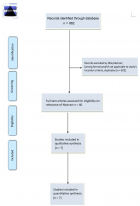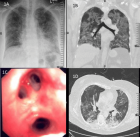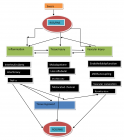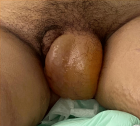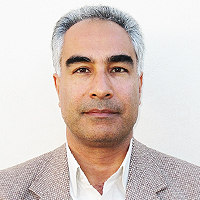Abstract
Review Article
Review of the Efficiency of Ten Different Commercial Kits for Extracting DNA from Soil Mixed Biological Samples
Neha Mundotiya*, Mukesh Choudhary, Saurabh Jaiswal and Umema Ahmad
Published: 19 July, 2023 | Volume 7 - Issue 1 | Pages: 017-024
Soil-mixed bodily fluids are the most common kind of evidence at outdoor crime scenes. This biological evidence contains DNA, which is a key component of forensic science’s ability to prove an accused person’s guilt because it connects the victim and suspect to the crime scene and aids in identifying the offender and victim. The yield of DNA is significantly influenced by factors including temperature, humidity, storage environment, time since deposition, etc. DNA degradation is caused by a variety of microbes, bacteria, humic acid, and other substances present in soil. Nowadays for DNA extraction, a variety of commercial DNA extraction kits was used now. This paper’s objective is to compare the efficiency of ten different commercial kits used to extract mixed DNA samples. It has been observed that samples stored at a low temperature (-20 °C) are the best for soil blood mixture samples. Compared to samples paired with other types of soil (silt, clay, and marshland), sand soil had the largest production of DNA using the QIAmp investigator kit (Qiagen). Blood Miniprep kit extractions were mostly inhibited, the control that amplified confirms that this kit was the worst in terms of DNA extraction potency. The samples with fewer dirt particles had a much greater yield of DNA.
Read Full Article HTML DOI: 10.29328/journal.jfsr.1001045 Cite this Article Read Full Article PDF
Keywords:
Mixed sample; Degradation; Humic Acid; Outdoor crime; Commercial kits
References
- Bogas V, Carvalho M, Anjos MJ, Pinheiro MF, Corte-Real F. Genetic identification of degraded DNA samples buried in different types of soil. Forensic Science International: Genetics Supplement Series. 2009; 2(1):169-171.
- Bonsu DOM, Higgins D, Austin JJ. Forensic touch DNA recovery from metal surfaces - A review. Sci Justice. 2020 May;60(3):206-215. doi: 10.1016/j.scijus.2020.01.002. Epub 2020 Jan 30. PMID: 32381237.
- Badu-Boateng A, Twumasi P, Salifu SP, Afrifah KA. A comparative study of different laboratory storage conditions for enhanced DNA analysis of crime scene soil-blood mixed sample. Forensic Sci Int. 2018 Nov;292:97-109. doi: 10.1016/j.forsciint.2018.09.007. Epub 2018 Sep 15. PMID: 30292937.
- Knietsch A, Waschkowitz T, Bowien S, Henne A, Daniel R. Metagenomes of complex microbial consortia derived from different soils as sources for novel genes conferring formation of carbonyls from short-chain polyols on Escherichia coli. J Mol Microbiol Biotechnol. 2003;5(1):46-56. doi: 10.1159/000068724. PMID: 12673061.
- Barbaro A, Cormaci P, Barbaro A. DNA analysis from mixed biological materials. Forensic Sci Int. 2004 Dec 2;146 Suppl:S123-5. doi: 10.1016/j.forsciint.2004.09.037. PMID: 15639555.
- Young JM, Rawlence NJ, Weyrich LS, Cooper A. Limitations and recommendations for successful DNA extraction from forensic soil samples: a review. Sci Justice. 2014 May;54(3):238-44. doi: 10.1016/j.scijus.2014.02.006. Epub 2014 Mar 11. PMID: 24796953.
- Levy-Booth D, Campbell R, Gulden R, Hart M, Powell J, Klironomos J, Pauls K, Swanton Clarence J, Trevors J, Dunfield K. Cycling of extracellular DNA in the soil environment, Soil Biol. Biochem. 2007; 39:2977–2991.
- Conklin AR. Introduction to soil chemistry: Analysis and instrumentation. John Wiley & Sons. 2013.
- Rohatgi RT, Kapoor AK. Effect of different types of soil and time intervals on isolation and quantification of DNA: a forensic management technology perspective. International Journal of Emerging Research in Management &Technology. 2014; 2278-9359.
- Kundu S, Mukherjee S, Bhattacharyya D. Effect of temperature on DNA double helix: An insight from molecular dynamics simulation. J Biosci. 2012 Jul;37(3):445-55. doi: 10.1007/s12038-012-9215-5. PMID: 22750982.
- Wartell RM, Benight AS. Thermal denaturation of DNA molecules: a comparison of theory with experiment. Physics Reports. 1985; 126(2):67-107.
- Toothman MH, Kester KM, Champagne J, Cruz TD, Street WS 4th, Brown BL. Characterization of human DNA in environmental samples. Forensic Sci Int. 2008 Jun 10;178(1):7-15. doi: 10.1016/j.forsciint.2008.01.016. Epub 2008 Apr 16. PMID: 18420364.
- Bing DH, Bieber FR, Holland MM, Huffine EF, Isolation of DNA from Forensic Evidence’, Protoc. Hum. Genet. 2000; 26:14.3.1.
- Willard JM, Lee DA, Holland MM. Recovery of DNA for PCR amplification from blood and forensic samples using a chelating resin. Methods Mol Biol. 1998;98:9-18. doi: 10.1385/0-89603-443-7:9. PMID: 9664549.
- Poetsch M, Markwerth P, Konrad H, Bajanowski T, Helmus J. About the influence of environmental factors on the persistence of DNA - a long-term study. Int J Legal Med. 2022 May;136(3):687-693. doi: 10.1007/s00414-022-02800-6. Epub 2022 Feb 23. PMID: 35195781; PMCID: PMC9005405.
- Kumar N, Maitray A, Gupta R, Sharma D, Shukla SK. Effect of Inhibitors on the Blood taken from Earthy Surfaces and DNA Profiling in Forensic Cases. 2017.
- Lasota T. Purification of human dna for dna profiling from body fluid contaminated soil using superparamagnetic iron oxide nanoparticles (spions)(Doctoral dissertation, University of Central Lancashire). 2014.
- Shahzad MS, Bulbul O, Filoglu G, Cengiz M, Cengiz S. Effect of blood stained soils and time period on DNA and allele drop out using Promega 16 Powerplex® kit. Forensic Science International: Genetics Supplement Series. 2009; 2(1):161-162.
- Pye K, Blott SJ. Particle size analysis of sediments, soils and related particulate materials for forensic purposes using laser granulometry. Forensic Sci Int. 2004 Aug 11;144(1):19-27. doi: 10.1016/j.forsciint.2004.02.028. PMID: 15240017.
- Chazottes V, Brocard C, Peyrot B. Particle size analysis of soils under simulated scene of crime conditions: the interest of multivariate analyses. Forensic Sci Int. 2004 Mar 10;140(2-3):159-66. doi: 10.1016/j.forsciint.2003.11.032. PMID: 15036437.
- Sugita R, Marumo Y. Screening of soil evidence by a combination of simple techniques: validity of particle size distribution. Forensic Sci Int. 2001 Nov 1;122(2-3):155-8. doi: 10.1016/s0379-0738(01)00490-x. PMID: 11672970.
- Robertson J, Thomas CJ, Caddy B, Lewis AJ. Particle size analysis of soils—a comparison of dry and wet sieving techniques. Forensic Science International. 1984; 24(3):209-217.
- Conklin AR. Introduction to soil chemistry: Analysis and instrumentation. John Wiley & Sons. 2013.
- Buś MM, Allen M. Collecting and preserving biological samples from challenging environments for DNA analysis. Biopreserv Biobank. 2014 Feb;12(1):17-22. doi: 10.1089/bio.2013.0060. PMID: 24620766.
- Bittencourt EAA, Soares-Vieira JA, Angeramis NG, da Silva CE, da Rocha Hirschfeld RC, Iwamura ESM. The analysis of biological samples from crime scene for a future human DNA profile confrontation. Effects of presumptive test reagents on the ability to obtain STR profiles for human identification. Forensic Science International: Genetics Supplement Series. 2009; 2(1):194-195.
- Yeates C, Gillings MR, Davison AD, Altavilla N, Veal DA. Methods for microbial DNA extraction from soil for PCR amplification. Biol Proced Online. 1998 May 14;1:40-47. doi: 10.1251/bpo6. PMID: 12734590; PMCID: PMC140122.
- Sangwan P, Nain T, Singal K, Hooda N, Sharma N. Soil as a tool of revelation in forensic science: a review. Anal Methods. 2020 Nov 21;12(43):5150-5159. doi: 10.1039/d0ay01634a. Epub 2020 Nov 2. PMID: 33135702.
- Rohatgi R, Kapoor AK. Effect of different types of soil and time intervals on isolation and quantification of DNA: a forensic management technology perspective. International Journal of Emerging Research in Management &Technology. 2014; 2278-9359.
- Shali SK. Applicability of Forensic Science in Criminal Justice System in India With Special Emphasis on Crime Scene Investigation. Medico-Legal Desire Media and Publications, Medico-Legal Reporter, Inaugural Issue. 2018.
- Hirashima H, Hisazumi R, Mason MLT, Yamamoto A, Saeki Y. Development of an effective method of human DNA extraction from soil as forensic evidence. Forensic Sci Int. 2022 Jun;335:111284. doi: 10.1016/j.forsciint.2022.111284. Epub 2022 Mar 26. PMID: 35398634.
- Kent AD, Triplett EW. Microbial communities and their interactions in soil and rhizosphere ecosystems. Annu Rev Microbiol. 2002;56:211-36. doi: 10.1146/annurev.micro.56.012302.161120. Epub 2002 Jan 30. PMID: 12142496.
- Howarth A, Drummond B, Wasef S, Matheson CD. An assessment of DNA extraction methods from blood-stained soil in forensic science. Forensic Sci Int. 2022 Dec;341:111502. doi: 10.1016/j.forsciint.2022.111502. Epub 2022 Nov 4. PMID: 36371979.
- Robe P, Nalin R, Capellano C, Vogel TM, Simonet P. Extraction of DNA from soil. European Journal of Soil Biology. 2003; 39(4):183-190.
- Dawson LA, Hillier S. Measurement of soil characteristics for forensic applications. Surface and Interface Analysis: An International Journal devoted to the development and application of techniques for the analysis of surfaces, interfaces and thin films. 2010; 42(5):363-377.
- Kasu M, Shires K. The validation of forensic DNA extraction systems to utilize soil contaminated biological evidence. Leg Med (Tokyo). 2015 Jul;17(4):232-8. doi: 10.1016/j.legalmed.2015.01.004. Epub 2015 Feb 7. PMID: 25690910.
- Sirker M, Schneider PM, Gomes I. A 17-month time course study of human RNA and DNA degradation in body fluids under dry and humid environmental conditions. Int J Legal Med. 2016 Nov;130(6):1431-1438. doi: 10.1007/s00414-016-1373-9. Epub 2016 May 16. PMID: 27184660.
- Bienvenue JM, Landers JP. DNA Extraction on Microfluidic Devices. Forensic Sci Rev. 2010 Jul;22(2):187-97. PMID: 26242596.
- Vuichard S, Borer U, Bottinelli M, Cossu C, Malik N, Meier V, Gehrig C, Sulzer A, Morerod ML, Castella V. Differential DNA extraction of challenging simulated sexual-assault samples: a Swiss collaborative study. Investig Genet. 2011 May 4;2:11. doi: 10.1186/2041-2223-2-11. PMID: 21542912; PMCID: PMC3119174.
- Lounsbury JA, Nambiar SM, Karlsson A, Cunniffe H, Norris JV, Ferrance JP, Landers JP, Enhanced Recovery of Spermatozoa and Comprehensive Lysis of Epithelial Cells from Sexual Assault Samples Having a Low Cell Counts or Aged up to One Year’, Forensic Sci. Int. Genet. 2014; 8:84–89: 54. DOI: 10.1016/j.fsigen.2013.06.015.
- Tan SC, Yiap BC. DNA, RNA, and protein extraction: the past and the present. J Biomed Biotechnol. 2009;2009:574398. doi: 10.1155/2009/574398. Erratum in: J Biomed Biotechnol. 2013;2013:628968. PMID: 20011662; PMCID: PMC2789530.
- Blake RD, Delcourt SG. Thermal stability of DNA. Nucleic Acids Res. 1998 Jul 15;26(14):3323-32. doi: 10.1093/nar/26.14.3323. PMID: 9649614; PMCID: PMC147704.
- Chong KWY, Thong Z, Syn CKC. Recent trends and developments in forensic DNA extraction. Wiley Interdisciplinary Reviews: Forensic Science. 2021; 3(2):e1395.
- Tsuchimochi T, Iwasa M, Maeno Y, Koyama H, Inoue H, Isobe I, Matoba R, Yokoi M, Nagao M. Chelating resin-based extraction of DNA from dental pulp and sex determination from incinerated teeth with Y-chromosomal alphoid repeat and short tandem repeats. Am J Forensic Med Pathol. 2002 Sep;23(3):268-71. doi: 10.1097/00000433-200209000-00013. PMID: 12198355.
- Vandenberg N, van Oorschot RA, Mitchell RJ. An evaluation of selected DNA extraction strategies for short tandem repeat typing. Electrophoresis. 1997 Aug;18(9):1624-6. doi: 10.1002/elps.1150180924. PMID: 9378133.
- Schoell WM, Klintschar M, Mirhashemi R, Pertl B. Separation of sperm and vaginal cells with flow cytometry for DNA typing after sexual assault. Obstet Gynecol. 1999 Oct;94(4):623-7. doi: 10.1016/s0029-7844(99)00373-7. PMID: 10511370.
- Zehner R, Amendt J, Krettek R. STR typing of human DNA from fly larvae fed on decomposing bodies. J Forensic Sci. 2004 Mar;49(2):337-40. PMID: 15027556.
- Walsh PS, Metzger DA, Higuchi R. Chelex 100 as a medium for simple extraction of DNA for PCR-based typing from forensic material. Biotechniques. 1991 Apr;10(4):506-13. PMID: 1867860.
- Bing DH, Bieber FR, Holland MM, Huffine EF, Isolation of DNA from Forensic Evidence’, Protoc. Hum. Genet. 2000; 26:14.3.1.
- Suenaga E, Nakamura H. Evaluation of three methods for effective extraction of DNA from human hair. J Chromatogr B Analyt Technol Biomed Life Sci. 2005 Jun 5;820(1):137-41. doi: 10.1016/j.jchromb.2004.11.028. Epub 2005 Apr 11. PMID: 15866502.
- Sweet D, Lorente M, Valenzuela A, Lorente JA, Alvarez JC. Increasing DNA extraction yield from saliva stains with a modified Chelex method. Forensic Sci Int. 1996 Dec 27;83(3):167-77. doi: 10.1016/s0379-0738(96)02034-8. PMID: 9032951.
- Drobnic K. Analysis of DNA evidence recovered from epithelial cells in penile swabs. Croat Med J. 2003 Jun;44(3):350-4. PMID: 12808732.
- Lorente M, Entrala C, Lorente JA, Alvarez JC, Villanueva E, Budowle B. Dandruff as a potential source of DNA in forensic casework. J Forensic Sci. 1998 Jul;43(4):901-2. PMID: 9670516.
- Marmur J. A Procedure for the Isolation of Decarboxyribonucleic Acid from Microorganisms, Mol. Biol. 1961; 3: 208–218.
- Primorac D, Andelinovic S, Definis-Gojanovic M, Drmic I, Rezic B, Baden MM, Kennedy MA, Schanfield MS, Skakel SB, Lee HC. Identification of war victims from mass graves in Croatia, Bosnia, and Herzegovina by use of standard forensic methods and DNA typing. J Forensic Sci. 1996 Sep;41(5):891-4. PMID: 8789853.
- Schmerer WM, Hummel S, Herrmann B. Optimized DNA extraction to improve reproducibility of short tandem repeat genotyping with highly degraded DNA as target. Electrophoresis. 1999 Jun;20(8):1712-6. doi: 10.1002/(SICI)1522-2683(19990101)20:8<1712::AID-ELPS1712>3.0.CO;2-6. PMID: 10435436.
Figures:
Similar Articles
-
Review of the Efficiency of Ten Different Commercial Kits for Extracting DNA from Soil Mixed Biological SamplesNeha Mundotiya*, Mukesh Choudhary, Saurabh Jaiswal, Umema Ahmad. Review of the Efficiency of Ten Different Commercial Kits for Extracting DNA from Soil Mixed Biological Samples. . 2023 doi: 10.29328/journal.jfsr.1001045; 7: 017-024
-
Environmental Factors Affecting the Concentration of DNA in Blood and Saliva Stains: A ReviewDivya Khorwal*, GK Mathur, Umema Ahmed, SS Daga. Environmental Factors Affecting the Concentration of DNA in Blood and Saliva Stains: A Review. . 2024 doi: 10.29328/journal.jfsr.1001057; 8: 009-015
Recently Viewed
-
Prediction of neonatal and maternal index based on development and population indicators: a global ecological studySedigheh Abdollahpour,Hamid Heidarian Miri,Talat Khadivzadeh*. Prediction of neonatal and maternal index based on development and population indicators: a global ecological study. Clin J Obstet Gynecol. 2021: doi: 10.29328/journal.cjog.1001096; 4: 101-105
-
A Genetic study in assisted reproduction and the risk of congenital anomaliesKaparelioti Chrysoula,Koniari Eleni*,Efthymiou Vasiliki,Loutradis Dimitrios,Chrousos George,Fryssira Eleni. A Genetic study in assisted reproduction and the risk of congenital anomalies. Clin J Obstet Gynecol. 2021: doi: 10.29328/journal.cjog.1001095; 4: 096-100
-
Leiomyosarcoma in pregnancy: Incidental finding during routine caesarean sectionToon Wen Tang*,Phoon Wai Leng Jessie. Leiomyosarcoma in pregnancy: Incidental finding during routine caesarean section. Clin J Obstet Gynecol. 2021: doi: 10.29328/journal.cjog.1001094; 4: 092-095
-
Adult Neurogenesis: A Review of Current Perspectives and Implications for Neuroscience ResearchAlex, Gideon S*,Olanrewaju Oluwaseun Oke,Joy Wilberforce Ekokojde,Tolulope Judah Gbayisomore,Martina C. Anene-Ogbe,Farounbi Glory,Joshua Ayodele Yusuf. Adult Neurogenesis: A Review of Current Perspectives and Implications for Neuroscience Research. J Neurosci Neurol Disord. 2024: doi: 10.29328/journal.jnnd.1001102; 8: 106-114
-
Late discover of a traumatic cardiac injury: Case reportBenlafqih C,Bouhdadi H*,Bakkali A,Rhissassi J,Sayah R,Laaroussi M. Late discover of a traumatic cardiac injury: Case report. J Cardiol Cardiovasc Med. 2019: doi: 10.29328/journal.jccm.1001048; 4: 100-102
Most Viewed
-
Evaluation of Biostimulants Based on Recovered Protein Hydrolysates from Animal By-products as Plant Growth EnhancersH Pérez-Aguilar*, M Lacruz-Asaro, F Arán-Ais. Evaluation of Biostimulants Based on Recovered Protein Hydrolysates from Animal By-products as Plant Growth Enhancers. J Plant Sci Phytopathol. 2023 doi: 10.29328/journal.jpsp.1001104; 7: 042-047
-
Sinonasal Myxoma Extending into the Orbit in a 4-Year Old: A Case PresentationJulian A Purrinos*, Ramzi Younis. Sinonasal Myxoma Extending into the Orbit in a 4-Year Old: A Case Presentation. Arch Case Rep. 2024 doi: 10.29328/journal.acr.1001099; 8: 075-077
-
Feasibility study of magnetic sensing for detecting single-neuron action potentialsDenis Tonini,Kai Wu,Renata Saha,Jian-Ping Wang*. Feasibility study of magnetic sensing for detecting single-neuron action potentials. Ann Biomed Sci Eng. 2022 doi: 10.29328/journal.abse.1001018; 6: 019-029
-
Pediatric Dysgerminoma: Unveiling a Rare Ovarian TumorFaten Limaiem*, Khalil Saffar, Ahmed Halouani. Pediatric Dysgerminoma: Unveiling a Rare Ovarian Tumor. Arch Case Rep. 2024 doi: 10.29328/journal.acr.1001087; 8: 010-013
-
Physical activity can change the physiological and psychological circumstances during COVID-19 pandemic: A narrative reviewKhashayar Maroufi*. Physical activity can change the physiological and psychological circumstances during COVID-19 pandemic: A narrative review. J Sports Med Ther. 2021 doi: 10.29328/journal.jsmt.1001051; 6: 001-007

HSPI: We're glad you're here. Please click "create a new Query" if you are a new visitor to our website and need further information from us.
If you are already a member of our network and need to keep track of any developments regarding a question you have already submitted, click "take me to my Query."







